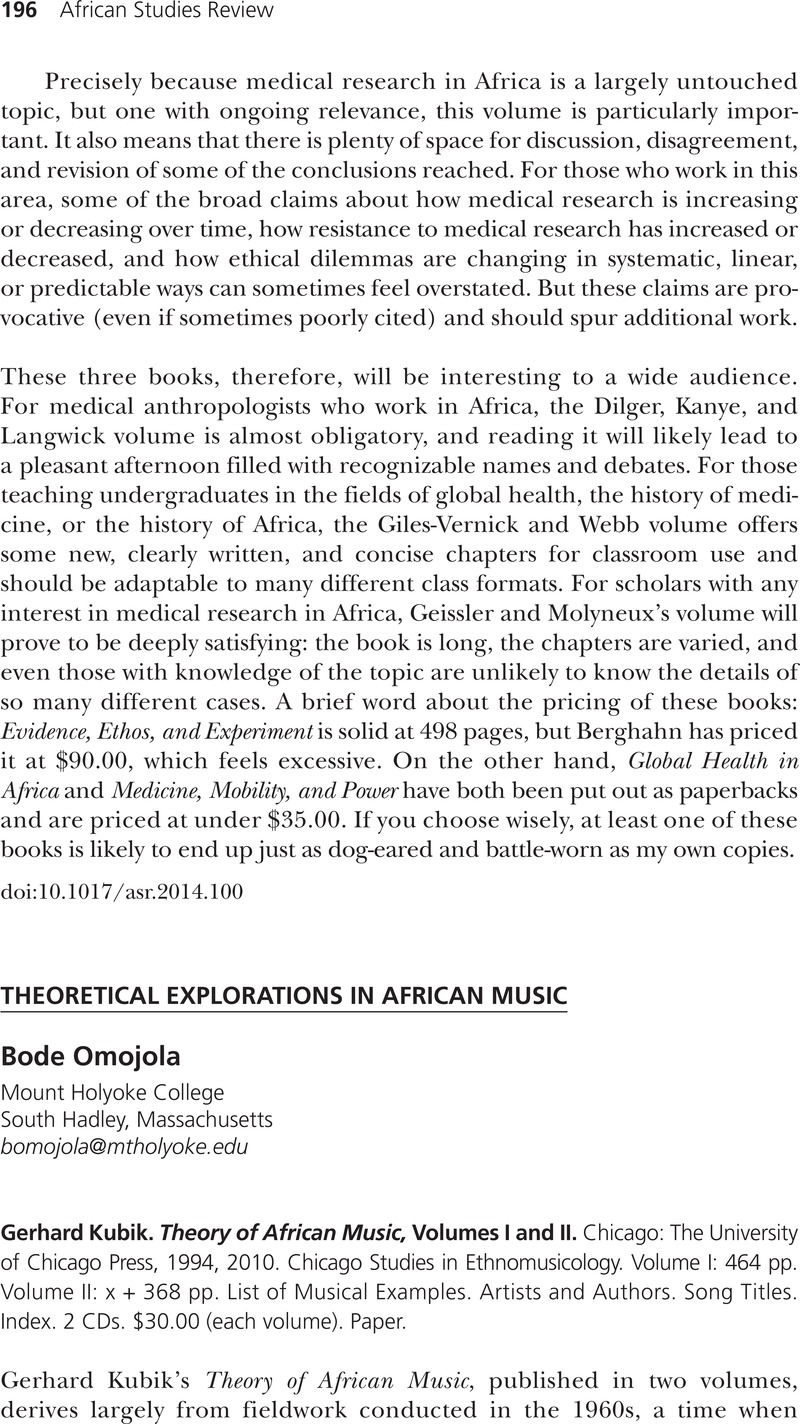No CrossRef data available.
Article contents
THEORETICAL EXPLORATIONS IN AFRICAN MUSIC - Gerhard Kubik. Theory of African Music, Volumes I and II. Chicago: The University of Chicago Press, 1994, 2010. Chicago Studies in Ethnomusicology. Volume I: 464 pp. Volume II: x + 368 pp. List of Musical Examples. Artists and Authors. Song Titles. Index. 2 CDs. $30.00 (each volume). Paper.
Review products
Gerhard Kubik. Theory of African Music, Volumes I and II. Chicago: The University of Chicago Press, 1994, 2010. Chicago Studies in Ethnomusicology. Volume I: 464 pp. Volume II: x + 368 pp. List of Musical Examples. Artists and Authors. Song Titles. Index. 2 CDs. $30.00 (each volume). Paper.
Published online by Cambridge University Press: 02 December 2014
Abstract
An abstract is not available for this content so a preview has been provided. Please use the Get access link above for information on how to access this content.

- Type
- BOOK REVIEW ESSAYS
- Information
- Copyright
- Copyright © African Studies Association 2014
References
Agawu, Kofi. 2006. “Structural Analysis of Cultural Analysis? Competing Perspectives on the ‘Standard Pattern’ of West African Rhythm.” Journal of the American Musicological Society 59 (1): 1–46.Google Scholar
Anku, Willie. 2006. “Circles and Time: A Theory of Structural Organization of Rhythm in African Music.” Music Theory Online 6 (1).Google Scholar
Berliner, Paul. 1981. The Soul of Mbira: Music and Traditions of The Shona People of Zimbabwe. Chicago: The University of Chicago Press.Google Scholar
Burns, James. 2010. “Rhythmic Archetypes in Instrumental Music from Africa and the Diaspora.” Music Theory Online 16 (4).Google Scholar
Kauffman, Robert. 1980. “African Rhythm: A Reassessment.” Ethnomusicology 24 (3): 393–415.Google Scholar
Kubik, Gerhard. 1964. “Xylophone Playing in Southern Uganda.” Journal of the Royal Anthropological Institute of Great Britain and Ireland 94 (2): 138–59.Google Scholar
Locke, David. 2011. “The Metric Matrix: Simultaneous Multidimensionality in African Music.” Analytical Approaches to World Music 1 (1): 48–72.Google Scholar
Ortiz, Fernando. 1940. Contrapunteo Cubano del Tabaco y el Azúcar. Havana: Jesús Montero.Google Scholar
Omojola, Bode. 2012. Yoruba Music in the Twentieth Century: Identity, Agency and Performance Practice. Eastman/Rochester Studies in Ethnomusicology. Rochester, N.Y.: University of Rochester Press.Google Scholar
Pike, Kenneth L. “Emic and Etic Standpoints for the Description of Behaviour.” In Language in Relation to a Unified Theory of the Structure of Human Behaviour, edited by Pike, K. L., 8–28. Glendale, Calif.: Summer Institute of Linguistics.Google Scholar
Shelemay, Kay Kaufman. 1997. “The Ethnomusicologist, Ethnographic Method, and the Transmission of Tradition.” In Shadows in the Field: New Perspectives for Fieldwork in Ethnomusicology, edited by Barz, Gregory F. and Cooley, Timothy J., 189–204. Oxford: Oxford University Press.Google Scholar
Waterman, Richard Alan. 1967. “African Influence on the Music of the Americas.” In Acculturation in the Americas, edited by Tax, Sol, 207–18. New York: Cooper Square Publishers.Google Scholar
Weiss, Sarah. 2008. “Permeable Boundaries: Hybridity, Music, and the Reception of Robert Wilson’s I La Caligo.” Ethnomusicology 52 (2): 203–38.Google Scholar




